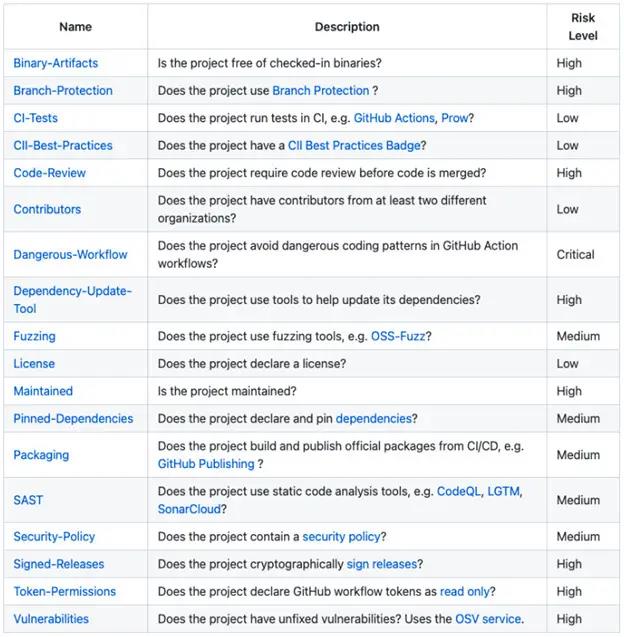当前位置:网站首页>OpenSSF's open source software risk assessment tool: Scorecards
OpenSSF's open source software risk assessment tool: Scorecards
2022-08-09 16:03:00 【SEAL Security】
For IT practitioners, Marc Andreessen's idea of "software eating the world" a decade ago is familiar.Whether in private life or the public sphere, software powers every aspect of modern society and is critical to modern economies and national security.
It is also a very popular view in recent years that open source has swallowed the software world.The Linux Foundation has predicted that Free Open Source Software (FOSS) accounts for 70% to 90% of modern software.Not only are modern software made up of a large number of open source components, but practitioners in the IT industry are also more willing to work with vendors who contribute to the open source community.
Open source software is widely used because of its flexibility, low cost, and the ability to drive innovation through community-based projects, and because of the collaborative participation of many people, the project can achieve better security, especially for large open source projects.Nonetheless, open source software has its own set of problems, including common vulnerabilities and exposures (CVEs) in the affected code.
CVE is a MITRE project dedicated to "identifying, defining, and classifying publicly disclosed cybersecurity vulnerabilities."However, the CNCF states in its Software Supply Chain Best Practices white paper that CVEs are "post-mortem indicators," meaning that the vulnerabilities they enumerate have all been publicly disclosed.They are also just one type of risk associated with software.
For this reason, organizations should use other methods to assess the security status of the open source projects they use.One of the most well-known projects is the Open Source Security Foundation (OpenSSF) Scorecards project.
Project address: https://github.com/ossf/scorecard
What are OpenSSF Scorecards?
Scorecards is designed to automatically generate security indices for open source projects to help project users and organizations make risk-informed decisions.Enterprises are making heavy use of open source dependencies, but identifying the risks of those dependencies is still a manual job.The Scorecards project aims to lighten the load with automated heuristics and safety checks, resulting in a safety index on a 0 to 10 scale.It aligns with best practices advocated by security leaders, such as signing or SAST, when evaluating security issues for open source software projects.

OpenSSF ScorecardsStratified scoring for risk severity
Scorecards can scan 1 million of the most critical open source projects based on direct dependencies and regularly publish the results on a public dataset.In addition to leveraging publicly available datasets, businesses can also use GitHub Actions to run Scorecards against their own GitHub projects, which run when the repo changes and provide alerts to the maintainers of those projects.
The Scorecards project uses a [Critical] [High] [Medium] [Low] scoring scale that is familiar to most security practitioners.It also uses a standard checklist to check against your target projects, whether public projects or private projects used natively.
You can also dive into some of these checks, including basic security practices such as using branch protection, cryptographically signed releases, and the presence of unfixed vulnerabilities.The Scorecards project uses the OSV vulnerability database (osv.dev) to detect the presence of unfixed vulnerabilities.This is a distributed vulnerability database designed for open source projects in OpenSSF OSV format.The core of OSV is to aggregate other vulnerability databases that use the OSV schema, such as GitHub Security Advisories and the Global Security Database.OSC also supports API and Command Line Interface (CLI) tools for scanning SBOMs in CycloneDX or SPDX format.
The Scorecards project has bi-weekly meetings and a Slack channel.Led by engineers from companies like Google, Datto, and Cisco, it has nearly 3,000 stars since its inception, and users have added it to their favorites.As enterprises continue to drive the maturity of their open source software adoption governance practices, the project will inevitably gain traction.
How does a business use OpenSSF Scorecards?
Currently, the governance and risk management capabilities of enterprises for open source software are still in their infancy.The frequent occurrence of software supply chain attacks in recent years will be a huge impetus for companies to strengthen their software supply chain security practices.We currently have the OpenSSF Security Mobilization Program, SLSA, the Secure Software Development Framework (SSDF), and other best practice guidelines.All of this involves managing the enterprise's use of open source software and ensuring that such use is consistent with the enterprise's tolerance for risk.
As simple as it sounds, doing this across a robust ecosystem of open source projects and components is challenging.OpenSSF's Scorecards project provides an automated way to gain security and risk insight into more than 1 million OSS projects and use that project directly for their own software and in-house projects.
Enterprises can use Scorecards via the CLI for projects they don't own, or use a package manager for projects like npm, Pypi, or RubyGems.Scorecards are also available as Docker containers.
Business and individual developers can participate in the program, including submitting requirements checks for scoring evaluation.Organizations can also customize their use of Scorecards, such as to run only specific checks, or to align with specific security requirements in their industry.
边栏推荐
猜你喜欢
随机推荐
【磁场建模项目2020-02-Lilin】采集板硬件规范
22岁测试工程师上来就内卷,起薪居然就18k,这谁顶得住?
C语言程序设计笔记(浙大翁恺版) 第五周:循环控制
Play in the cloud | The ever-changing gameplay of Tianyi cloud computer
概率论基础知识整理 | 概率论的基本概念
Shell编程之循环语句
Item 37: Make std::threads unjoinable on all paths.
vivo手机上的系统级消息推送平台的架构设计实践
OpenCV笔记整理【视频处理】
【OpenGL】四、OpenGL入门总结:LearnOpenGL CN教程中关于欧拉角公式推导
技术分享 | 接口自动化测试如何处理 Header cookie
凡尔赛一波:凭这份阿里面试突击指南,我已经拿了9张Offer
实践数据湖iceberg 第三十九课 清理快照前后数据文件变化分析
百度地图——地图找房功能
兆骑科创创新创业大赛平台,人才引进,项目路演
Technology Sharing | How to Handle Header Cookies in Interface Automation Testing
Mysql两个引擎对比
网站授权QQ登录
Mind map FreeMind installation problems and simple use
ORDER BY clause is invalid in views, inline functions, derived tables, subqueries, and common table expressions unless TOP, OFFSET, or FOR XML is also specified



![[DevOps] jekins deployment (1)](/img/ee/3c7ee4d37aee91753bac6519daa7e1.png)





